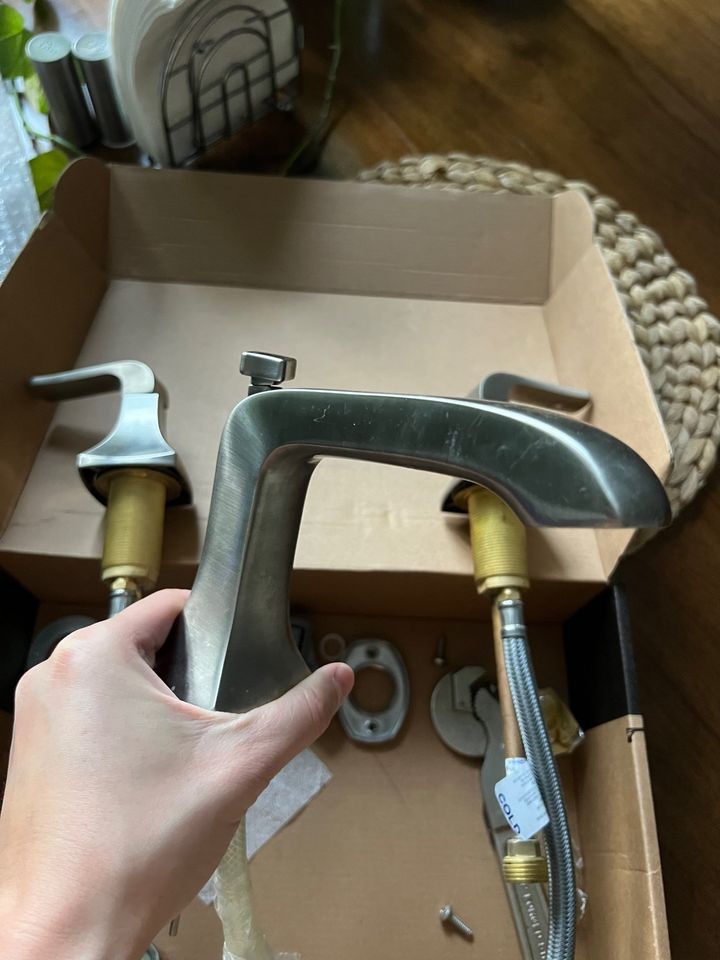Ah, the bathroom faucet! It’s not just a piece of shining (or maybe tarnished?) metal—it’s the unsung hero making your morning rituals smoother. But let’s be honest if you’re spending more time with a wrench than a toothbrush, it’s probably crying out for a swap.
Why Even Bother Replacing Faucet in Bathroom?

Think of your faucet like that old pair of jeans from the ’90s. Sure, they might still work, but they’re not exactly screaming modern elegance. Whether it’s lost its shine or, even worse, developed the annoying habit of dripping, it’s a clear sign it’s past its prime.
If your recent Google history involves the term “latest bathroom designs”, a faucet switch is a quick win. And don’t get us started on the plethora of styles available now. Do you want a rose-gold, waterfall-style faucet? They’ve got it.
Listen, we’re all about saving the planet one drop at a time. And you can too, by looking for newer faucet models. They’re like the smartphones of the plumbing world—efficient and stylish.
Constant drips can test anyone’s patience. And, let’s face it, that makeshift solution of tying a thread around the tap? Not the best look.
Never replaced a bathroom faucet before? No problem! It’s like building that complex IKEA shelf but way simpler if you’ve got the right guidance. Dive into our step-by-step approach, peppered with tricks from our experts who’ve been in the trenches (or under the sinks) more times than they can count.
Tools and Materials Needed
- Adjustable Wrench: The superstar of plumbing. Loosening, tightening, fidgeting: this one’s your go-to.
- Basin Wrench: Tailor-made for those hard-to-reach spots beneath the sink. Remember the last time you cursed the heavens trying to get to that one nut? Yeah, basin wrench to the rescue.
- Plumber’s Tape: A little wrap around the threads can prevent leaks. Think of it as the faucet’s fashion accessory that’s also functional.
- Plumber’s Putty: Essential for sealing the base plate. Because water has a naughty habit of going places it shouldn’t.
- Bucket & Rags: Because let’s be honest, things can get wet, and not in a fun way. Best be prepared.
- Supply Lines: If your old ones look a bit worse for wear, don’t play hero. Replace them.
- Silicone Caulk: For that watertight seal. Like the bouncer of the faucet world: nothing gets past it if it isn’t supposed to.
- Teflon Tape: Ensures a tight seal on threaded joints. It’s like the extra insurance for your connections.
- Pipe Cutter: Just in case your supply lines don’t match up perfectly. But hey, be gentle, it’s not a sword!
- New Faucet: Well, duh. Choose wisely. This is the crown jewel after all.
Removing the old faucet
- Turn Off the Water Supply:
To avoid any impromptu indoor water fountains, always start by shutting off the water valves located under the sink. They’re usually simple knobs that you can turn by hand. If they’re stubborn or not present, you might have to turn off the main water supply. - Clear and Protect the Area:
Make sure you’ve cleared out the under-sink area, and lay down some towels or a basin. This isn’t your first rodeo, and you know water has a way of going everywhere you don’t want it to. - Disconnect Water Lines:
With an adjustable wrench, gently disconnect the water lines from the old faucet. And remember, a bit of residual water is totally normal, so keep that cloth or towel handy. - Loosen and Remove Nuts from Old Faucet:
Under the sink, you’ll find nuts holding your faucet in place. Using a basin wrench or a similar tool, loosen these up. If rust or age makes this a challenge, penetrating oil can be your secret weapon. Let it sit for a few minutes and try again. - Lift Out the Old Faucet:
Now, from above the sink, lift out the old faucet. If it’s being stubborn, gentle wiggling will usually get the job done. - Clean the Surface:
Over time, gunk, old plumber’s putty, or lime build-ups can accumulate. Give the sink surface a good clean to ensure a fresh, smooth foundation for your new faucet.
Installing the New Bathroom Faucet

Alright, the old faucet is history. Now, for the magic moment of bringing in the shiny new one. Let’s dive right into the deep end (without getting wet, of course).
Steps on How to Install Bathroom Faucets
- Check the Installation Instructions: Manufacturers sometimes have specific installation nuances. Always refer to the user manual provided for any peculiar steps.
- Position the Gasket and Faucet: Place the rubber or plastic gasket, provided with the new faucet, over the holes in the sink. Position your faucet atop this gasket ensuring it aligns with the sinkholes.
- Secure the Faucet: From beneath the sink, slide the plastic or metal washers over the faucet tailpieces. Then, tighten the mounting nuts until the faucet sits snugly.
- Connect Water Supply Lines: Attach the water supply lines to the faucet tailpieces. Firmly tighten these connections, but be careful not to Hulk-out on them.
- Flush the Faucet: Before you get too excited, remember to flush the faucet. This ensures that any debris or sediment in the lines doesn’t clog your aerator. Simply turn on the water and let it run without the aerator for a few minutes.
- Re-attach the Aerator: Once flushed, screw back the aerator onto your faucet.
Tips on Installation for Different Types of Sinks
- Undermount Sinks: These are trickier due to their below-the-counter positioning. Often, installing the faucet requires mounting it to the countertop itself. Ensure you’ve sealed around the faucet base to prevent any water from sneaking below.
- Pedestal Sinks: Space is a luxury with these. You might want to connect your supply lines before placing the sink against the wall.
- Vessel Sinks: These beauties sit atop your counter. Ensure your faucet is tall enough to reach over the side of the sink and that the spout has enough reach to get water into the basin without splashing.
Installing a Faucet in a Bathroom with Limited Space
Cramped space? No worries. Sometimes, it’s all about strategy:
- Pre-assembly: Assemble as much of the faucet as you can outside of the sink area. This minimizes the fumbling you’ll have to do in tight quarters.
- Tools to the Rescue: Basin wrenches are invaluable in tight spaces. It’s designed to reach and turn nuts that are nearly inaccessible.
Post-Installation Steps
- Check for Leaks: After installing, turn on the water and inspect each connection point for drips.
- Tidy Up: Clean the area and remove any debris or tools. A fresh install deserves a clean environment.
- Routine Check: Return after a few hours and check once more for any moisture or drips. Better safe than sorry, right?
Considerations When Replacing Sink Faucets
- Compatibility: Ensure that the faucet you’ve chosen is compatible with the number of holes in your sink or counter.
- Size Matters: Does your sink accommodate the faucet’s height and reach? These considerations ensure no over splash and a comfortable user experience.
- Water Pressure: Different faucets may come with varying water pressure levels. It’s good to check if the chosen faucet suits your household’s water pressure.
Replacing Faucet Valve or Changing Faucet in Bathroom Sink
Sometimes, the faucet isn’t the only component that needs changing. If you’re facing issues with your faucet valve:
- Identify the Problem: If your faucet is dripping despite being tightly closed, the valve might be the culprit.
- Choosing the Right Valve: Valves come in many types – compression, cartridge, ball, and ceramic disk. It’s essential to replace the old valve with a compatible new one.
- Replacing the Valve: Once you’ve identified the problem and have the right replacement, turn off the water, unscrew the faucet handle, and swap out the old valve for the new one.
Frequently Asked Questions (FAQs)
Absolutely! Replacing a bathroom faucet is a doable DIY project, especially if you’re comfortable with basic tools and following instructions. With the right guidance, tools, and a bit of patience, you can successfully replace a bathroom faucet yourself.
Anyone with a willingness to learn, a bit of DIY spirit, and some basic tools can replace a bathroom faucet. You don’t need to be a plumbing expert, but a little familiarity with common tools and some patience will go a long way.
The cost of replacing a bathroom faucet can vary based on the type of faucet you choose and the brand. On average, you can expect to spend anywhere from $50 to $300 on a new faucet. Keep in mind that this cost can also include any tools you might need to purchase if you don’t already have them.
The time it takes to replace a bathroom faucet depends on your level of experience and the complexity of the installation. If you’re a beginner, it might take around 1 to 2 hours to complete the project. However, if you’re more experienced and familiar with the process, you might be able to finish it in as little as 30 minutes.
A dripping bathroom faucet can be caused by a few common culprits. The most typical reason is a worn-out washer, seal, or O-ring inside the faucet. Over time, these parts can wear out due to regular use, leading to a slow drip. Another possible cause is a damaged or corroded valve seat, which can allow a small amount of water to trickle through even when the faucet is off. We have a complete guide on how to fix a leaking faucet, be sure to check it.
Leaky faucets can be a result of several issues. One of the main reasons is wear and tear on the internal components, like washers and O-rings. Mineral deposits from hard water can also accumulate over time and interfere with the sealing capabilities of the faucet parts. Additionally, if parts of your faucet aren’t correctly tightened or have become loose over time, it can cause a leak.
Yes, for most homeowners, installing a bathroom faucet is considered a manageable DIY task. However, ease of installation can vary based on the type of faucet and the existing setup in your bathroom. With the right tools, a step-by-step guide, and some patience, you can typically handle this project without the need for a professional. Just remember to shut off the water supply before you begin!
Conclusion
Replacing a bathroom faucet might seem daunting, but with the right tools and guidance, it’s a task you can confidently tackle. Whether you’re sprucing up your space or addressing a leaky nuisance, this guide has got you covered. Here’s to successful home improvements and the satisfaction of a job well done. Cheers to your revamped bathroom!
Last Updated on August 15, 2023

Dustin Hopkins has over 12 years in the cleaning industry, working in the past for one of the top 5 cleaning companies in the US. Currently, he is the chief editor of CleaningRank.com and the proud father of a 5-year-old, Chris.
